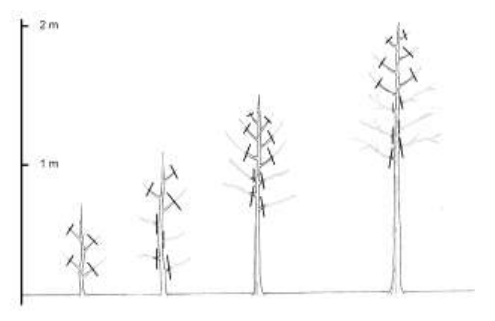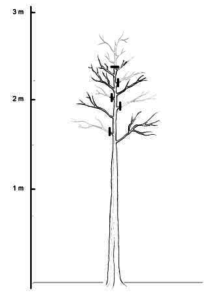Formative pruning for open centered fruit trees
Forming the trunk

Formative pruning standard tree. First 4 winters. Image Paul Lacey Natural England
- Winter 1. Prune back any side shoots (sometimes referred to as ‘feathers’) to two or three buds. These will be cut back to the main stem in the following winter prune. This encourages the stem to thicken and builds a strong upright trunk to support the head of the tree.
- Do not prune the leader.
- Subsequent winters. Continue to prune back new side shoots to two or three buds (then remove at base the following year) until the central stem has reached the height you want it. The height at which you first develop framework branches will be the height at which they remain throughout the life of the tree. Do not prune the leader until you have reached the height you want your framework branches.
- Standards. If you are forming a standard, you want to let the central leader grow to about 2m (6 ft) before allowing side-shoots to develop. This will be where the framework branches will grow, out of the way of grazing livestock.
- Half standards. Let the leader grow to about 1 or 1 ½m (3-5 ft) before allowing side-shoots to develop. This will be where the framework branches grow from, and so will be the final height of the central trunk. With half-standard trees, the framework branches should be formed upwards in place of the trunk to create a multi-stemmed tree.
Forming the framework branches
-

Developing framework branches. Open centre. Winter 5_ Based on illustration by Paul Lacey Natural England
When the trunk is the height you would like your first framework branches to grow from, leave the side shoots at this height un-pruned. Select three or four of these that are evenly spaced and that form wide angles with the trunk, prune them by half to an outward facing bud. These will become your first framework branches.
- You might or might not want to produce further tiers of framework branches. If so, keep the central leader un-pruned and repeat this process. This is known as delayed open centered tree form.
- Leave 20cm (8 inches) of trunk between each branch to spread out the strain that each puts on the trunk. Ideally you are looking to end up with a tree that has a strong central stem with six to eight framework branches coming off it, evenly spaced around the central trunk.
- When your tree has reached the height you want your trunk to reach, prune the central leader to this point. From this time on, the growth of the trees will be directed through the framework branches
Pruning framework branches
- While you are establishing your framework branches, prune them by one third of that years’ growth to encourage the formation of strong branches and well-spaced laterals.
